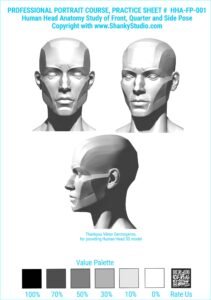Title of Tutorial
Learn how to draw and shade the front-facing human face, using a pencil, from memory, without relying on any reference pictures.
Audience
Through the use of the prescribed methodology at www.ShankyStudio.com, we have observed that 99% of the participating children age 7+, adults and novices, are able to draw portraits from the memory.
Objective
After completing this exercise, you will be able to draw technically correct and aesthetically pleasing front-facing human faces, from memory, without relying on any reference pictures. Drawing from memory offers the ultimate freedom and joy of creation!
Material Required
- Download and take prints of the practice sheets HHA-FP-001 to HHA-FP-005, from the link mentioned below –
- A well-sharpened 2B pencil.
- The expected practice time is 8 to 10 hours. Practice, that is, repetition, is the key. It’s often said that you can learn to draw by drawing, just as we learn to write the alphabet.
Methodology
Analysis
Use HHA-FP-001 sheets for studying and analysing the human head anatomy, from drawing and shading perspectives.
2D Drawing Process
In practice sheet HHA-FP-002, refer to the drawing on the right, and draw the lines on the left side with a pencil, repeating 10 times. While practicing the drawing, take the help of an 8 by 5 grid, and observe and memorize the relative positions, angles, sizes, and shapes of the features and plains of the face. Start drawing the external envelope, that is, silhouette, and then focus on the inner micro details. Draw with a light hand, as the lines are just containers for shading to take place.
3D Shade Process
In practice sheet HHA-FP-003, refer to the shading on the right, and shade the plains on the left side with a pencil, repeating 10 times. While practicing shading, do observe, understand, and memorize the impact of light on the different plains of the face. For example, the plains facing the light will appear bright, while the opposite side will be dark. Plan your value palette based on the spectrum of light and shadow, which includes black, dark, light, and white tones. This value palette will serve as a guide for shading the portrait. Ensure that the shade value is correct and matches the right side of the face. While using the 2B pencil, use the pressure and layering technique to darken the value of the shade. Identify the darkest planes first, and start shading them.
Create Portrait from Memory
Once you are able to memorize the drawing and shading process, try to create a portrait from the memory, that is, without referring to the practice sheets. For your first few attempts, you may find it helpful to use the practice sheet HHA-FP-004 to draw the portrait. Practice it a couple of times and you will be able to draw the portrait from the memory.
Create Variations
After that, you may use your imagination and change the portrait to a male, or female, or add a minor expression on the face, which we will discuss in the forthcoming tutorials. You may study the practice sheet HHA-FP-004, which has a single source of light, that is, on the top right corner. A single source of light will make the left portion of the portrait darker. Use practice sheet HHA-FP-005, and draw and shade the portrait with a single source of light.
Similarly, you may learn the side pose by using the sheets HHA-SP-006 to HHA-SP-008.
Conclusion
Remember that learning to draw pencil portraits from memory takes time and dedication, but with acute observation and consistent practice, you can develop these skills easily.
If you found this tutorial valuable, do share and spread the happiness to others. You may share your star rating and feedback at https://g.page/ShankyStudio/review
Stay tuned for the next tutorial!










